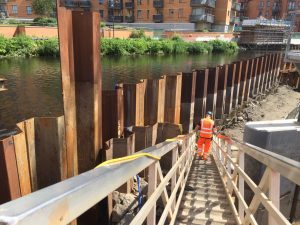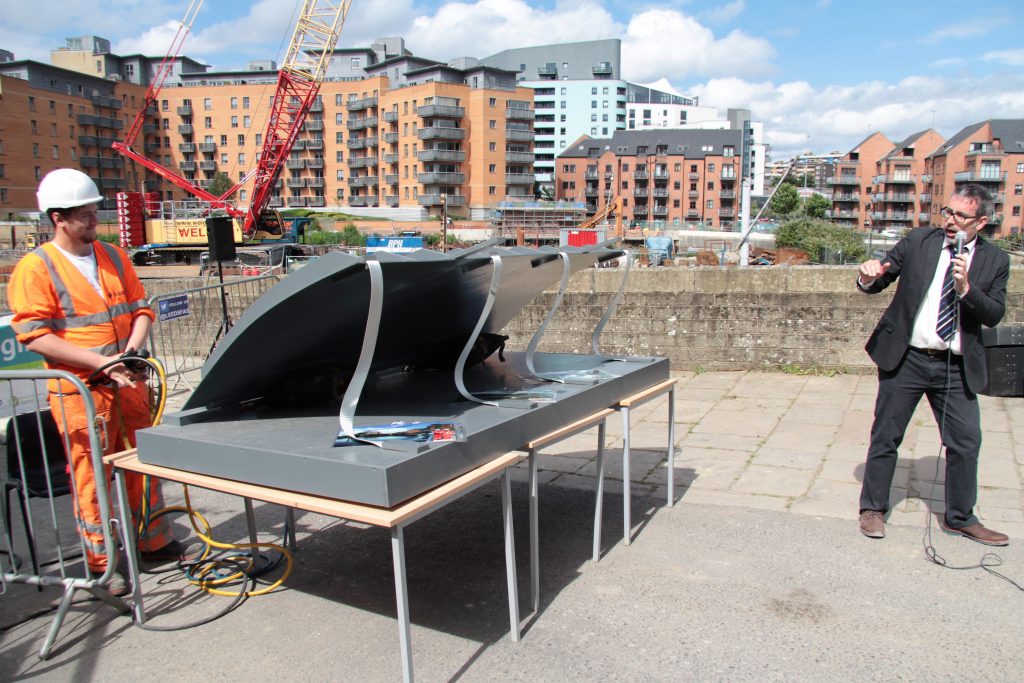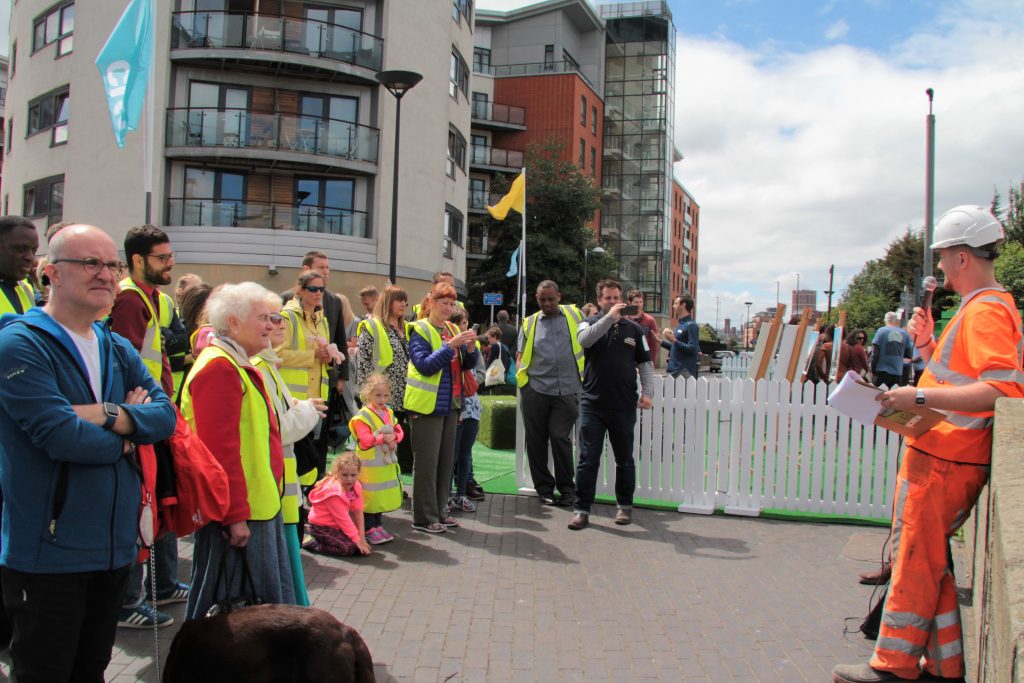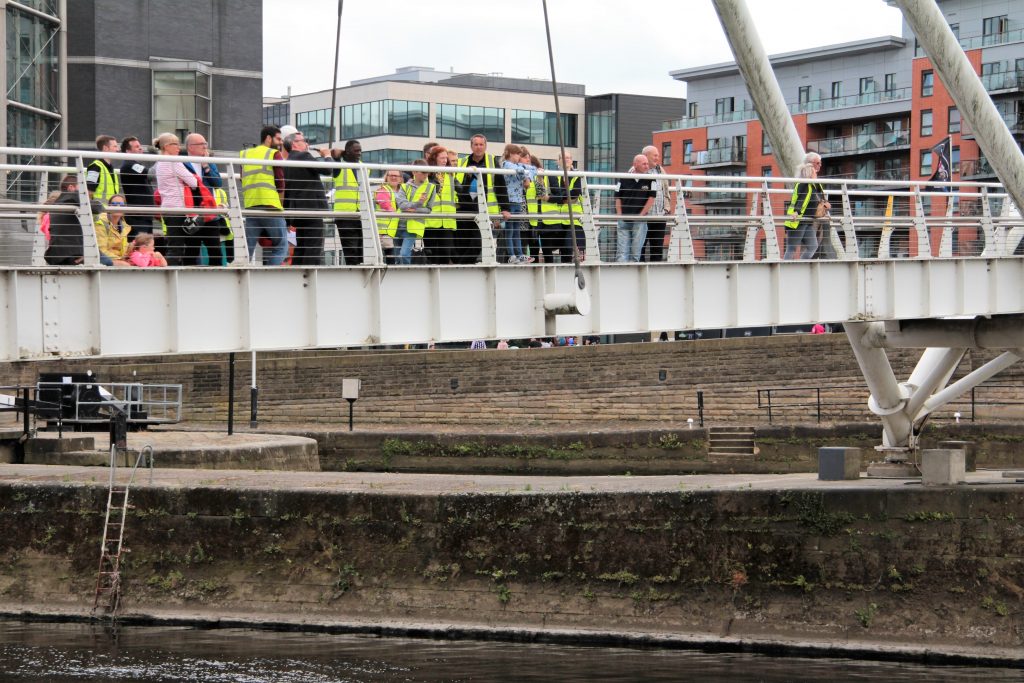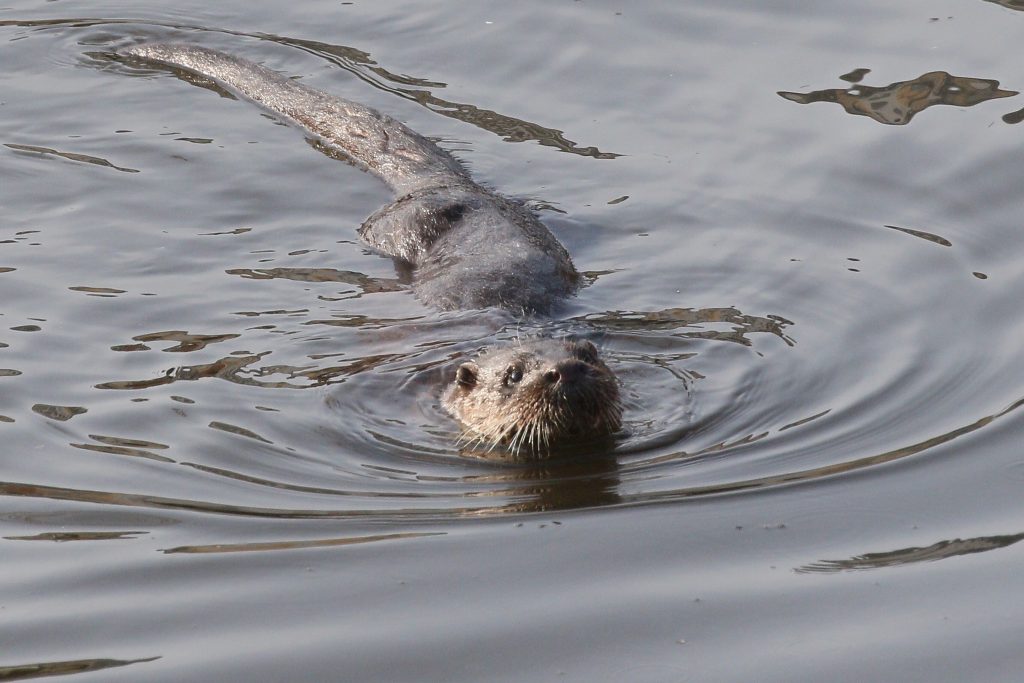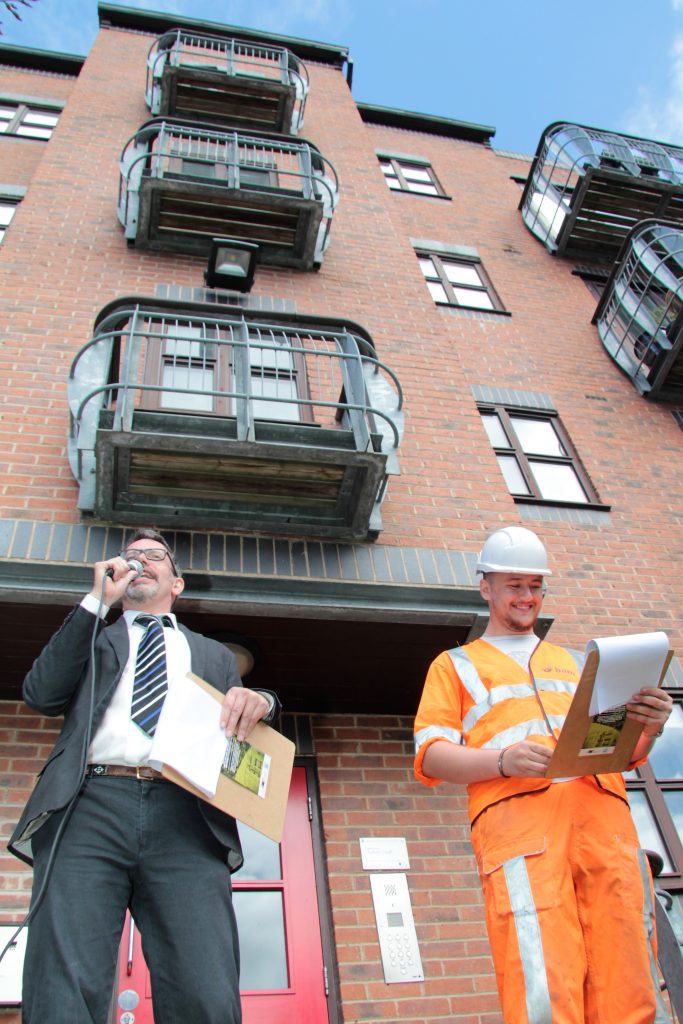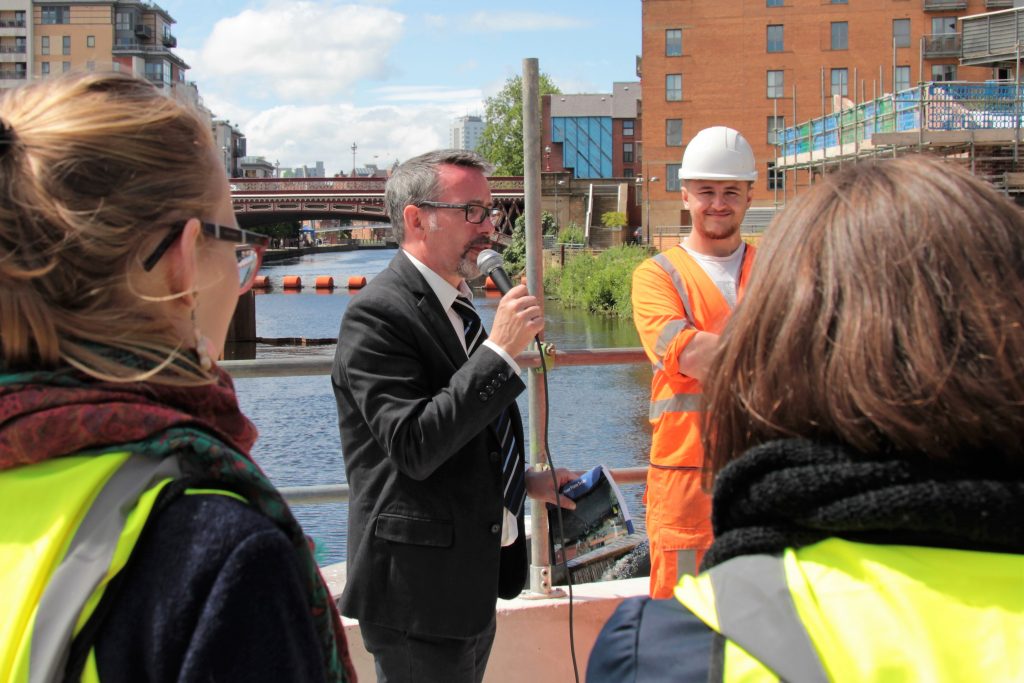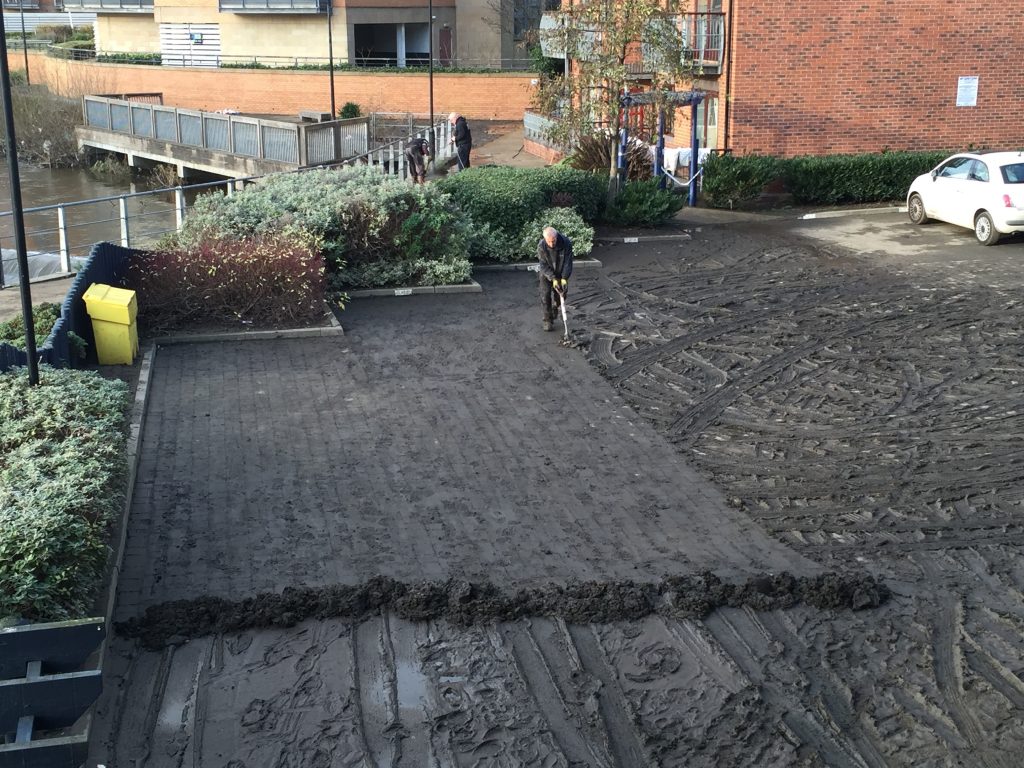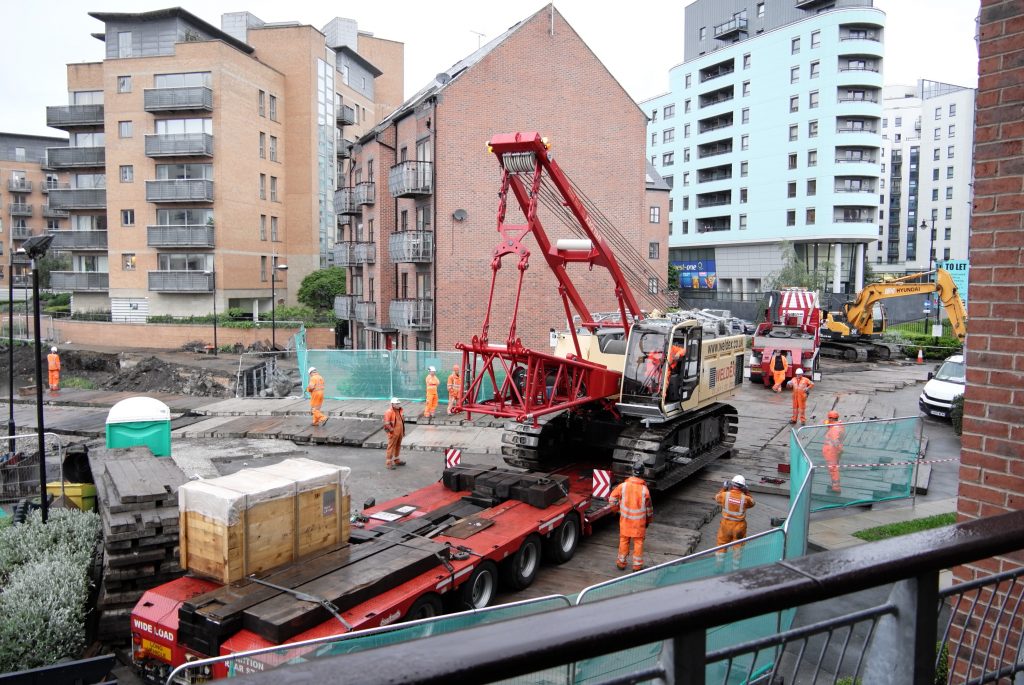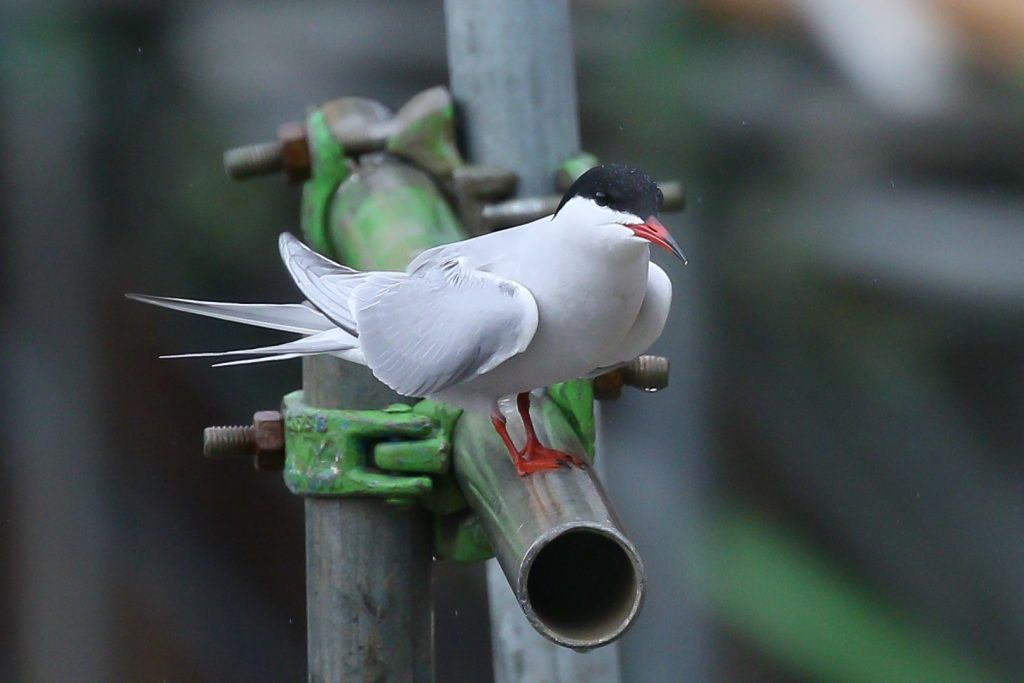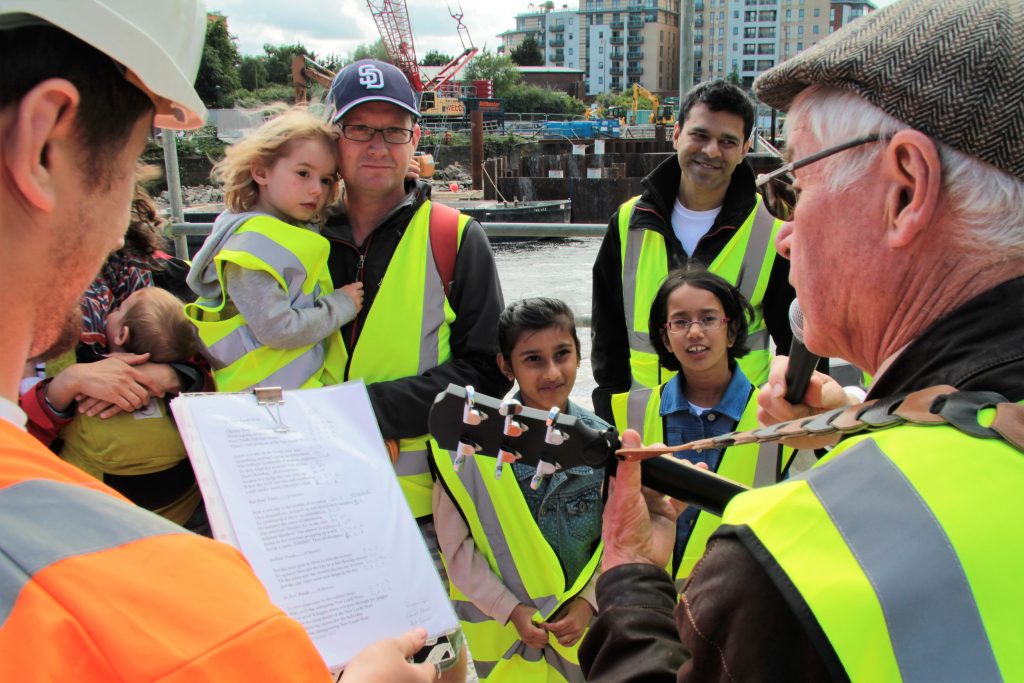Weir Science was Multi-Story Water’s third and final performance contribution to the Leeds Waterfront Festival, which takes place annually on the last weekend in June (previous contributions were 2015’s Seven Bridges and 2016’s After the Flood).
This performance was presented in collaboration with BAM Nuttall, the engineering contractors responsible for the delivery of the £47m Leeds Flood Alleviation Scheme (commissioning partners include Leeds City Council and the Environment Agency). The FAS scheme (and indeed the performance) centres around a retractable weir system, installed in place of two of the city’s old, industrial weirs. The task of Weir Science was to engage the general public with this scheme, during the festival weekend, in an entertaining and informative way.
For full details on this project, please see:
this blog post, detailing some of our research into the weir installation, and/or
this blog post, reflecting on the performances and public responses to them.
In what follows below, we offer an illustrated version of the script for the walkabout performance, as well as selected video clips.
Weir Science
(text by Steve Bottoms; improvised around during performance)
ONE: We begin in the FAS site compound, next to the River Aire at Crown Point.
GUY is dressed in a suit, tie and loafers. JACK is in head-to-toe orange construction worker gear with hard hat. Both have clipboards, and they pass a mike between them as necessary.
GUY (giving it the hard sell): Ladies and Gentlemen, welcome to Weir Science! The story of Leeds’s brand new state-of-the-art weir, right here, at Crown Point. I’m Guy – from the Council — and this is my glamorous assistant Jack …
JACK: (leaning into mic, deadpan) … of all trades.
GUY: I represent the people who commissioned this remarkable, collapsible, pneumatic weir…
JACK: …and I’m the one actually building it.
GUY: That’s “pneumatic” as in “the science of gases” — in this case, air, because this system relies on a great big pressurised air bladder. (indicating the mock-up weir gate) You can see from this handy-dandy, scaled-down demonstration model here how this new weir mechanism works… Just imagine the river flowing right over the top of it here… and falling down over the weirgate in a little waterfall… (he gestures extravagantly to illustrate) That’s how it will go most of the time, but then – when there’s been particularly heavy rainfall and there’s a risk of flooding…
(JACK, behind the model, presses the buttons to deflate the air bags part way)
… we just deflate the airbags to lower the weir gate, and so lower the level of the river coming through Crown Point… If it rains even harder, we lower the gate further….
(JACK lowers gate further)
… And then in a full-on, one in one-hundred-year flood event, we lower it all the way down…
(Gate is flattened.)
Then finally, when the high water has subsided again, we just reflate the airbags, to return the weir to its original position…
(JACK does so – and so disappears again behind the rising gate)
… And that way we don’t have to look at Jack any more! (forced laughter) Now Jack, what are these strappy things on the front…?
JACK: (coming back round front) Oh these are retaining straps — they act as a restraint to stop the weir plates lifting too far… So there’s a kind of push-pull tension involved…
GUY: Brilliantly simple really. (Just like Jack here.) And yet also innovative! This is a first for Leeds – it’s the first time in this country that this technology has been used as a flood alleviation measure.
JACK: We’re going to take you on a walk across the river now, to show you the real thing…
GUY: Yes, but before we do – a few words about the wider scheme! The Crown Point weir is one of three main components to the Leeds Flood Alleviation Scheme…There’s also a second weir – a larger one in fact – already completed downstream at Knostrop…
JACK: Yeah, we did that one first, figured it out as we went – so this one has been fairly straightforward by comparison…
GUY: And then there’s what we call the “linear works” – because they’re all in a line, basically! That’s the new flood walls that you’ll see through the city centre, up as far as the station.
JACK: And that’s basically just building walls. Which is not nearly as much fun to work on as this… (indicating the enormous crane on the island in the middle of the river)
GUY: Flood walls are of course very common in schemes of this sort… Build ’em higher, keep the water out, right? And originally, the plan for Leeds’s flood defences was mostly based on building walls… But these walls would have had to be really quite high, and we at the Council had some concerns about that. We didn’t want to to turn all our waterfront paths into walled-off alleyways for drunks and muggers to hide in! (attempts a laugh – fails) So we looked again at the weirs… Now then: I’m not going to lie to you, the council tax payers of Leeds… a fancy weir like this costs quite a bit more than building walls. And it is rare, in the world of flood defences, to spend so many millions of pounds on such a specific scheme that will protect such a limited stretch of river… Basically, we reckon this collapsing weir will affect river levels upstream about as far as Victoria Bridge…
JACK: That’s the bridge by the Dalek building – Neville Street…?
GUY: So – not even as far as the station. Usually a big flood scheme will cover a much wider area, geographically speaking. But this is the centre of Leeds we’re talking about! Better flood protection here will mean that people are more likely to invest in this city… particularly in all the disused areas on this Southern side of the river… (fast, as if reciting terms and conditions) We reckon there’s potentially 35,000 new jobs in regenerated brownfield sites in the city centre… (in conclusion:) So we at the Council really fought for this scheme — and we’re underwriting the costs, basically!
JACK: (getting impatient) Are we going to start this tour, then?
GUY: Yes, right. Don’t you need to do a safety briefing or something?
JACK: Oh yeah, sorry. Right, listen up folks. (reading from list) “Visitors SHOULD:
- Wear your high-vis jacket or vest at all times. [vests distributed to audience]
- Observe all safety signs and instructions.
- Only smoke in designated smoking areas…”
Well we won’t actually take you to any of those, so no smoking basically… (checking sheet)… “Visitors MUST NOT:
- Report to site under the influence of alcohol or drugs
- Indulge in horseplay
- Interfere with or misuse anything provided for health, safety and welfare.
- Pump water into the river without permission.
- Leave the company of your escort.”
GUY: That’s us.
JACK: (scanning list) Yeah, the rest of this isn’t really relevant… OK let’s go!
(He sets off towards next tour location)
GUY: (scuttling along behind) Ha ha ha, he’s not just your average hairy-bottomed builder is he…?!
TWO: At the base of Knight’s Way bridge, overlooking the navigation and Fearns’ Island.
JACK: (with the mic, as audience… as if sharing a confidence) You know, people in suits and ties sometimes look down on construction workers. Some of them think we’re just monkeys in hard hats. They forget that we might have decades of operational experience. They forget that we’re so highly skilled that we get moved around the country in teams, to where we’re most needed. Whether it’s power stations. Motorways. Weirs… I’m from Hartlepool, myself. I’m down here working in Leeds all week, and I only get back up to see me missus on weekends. Although this weekend I’m stuck here doing this… So I’m just saying. Let’s not take people for granted.
Case in point. They want us to build this weir, but we have to figure out the logistics of actually doing it… How do you think we got this massive crane up on the island here?
- First of all we had to close off the navigation here, to boats…
- Then we lowered 4 massive steel tubes into the channel, at the narrowest point just there. These are like pipes, to let the water through.
- Then we build a stone bridge across the top of these tubes, so as to drive a mobile crane over to the island – 110 tonnes of it…
- We use the mobile crane to build this 250 tonne crane you see here. The counterweight alone is 86 tonnes …
- Then finally we drive the mobile crane back off the island, take the stone and steel back out, and go on from there…
GUY: (amused) And then in August or September, when the job’s finished, you have to do the whole thing all over again in reverse…
JACK: (coolly) Yeah. Right.
GUY: (taking the mic) Now if anyone here is unsure how heavy a “tonne” actually is, well it’s roughly the weight of a fully grown polar bear. So if you can imagine that crane as 250 polar bears, laid end to end, then you’re getting close… Now, I should just say that our friends over there at the Canal and River Trust (indicating the CRT building across the river) are a bit concerned about that crane coming down… The CRT are all about boats and boating — they’re responsible for maintaining this navigation section of the river, with the lock… (he points it out) And they won’t be best pleased if it gets closed off to boaters again for 2 weeks in the height of the holiday season, just to get a crane down…
JACK: (cool) But that’s just how it’s panned out I’m afraid. Originally we were due to finish these works in March – but the whole project got put back months by the Boxing Day flood in 2015 – and by the high river levels we had that whole winter…
GUY: (shamed) Well, that’s fair enough I suppose. And actually, in one sense, this whole project is for the benefit of boaters… I mean, one way to lower the river levels in Leeds permanently would just be to take the weirs out completely… but if we did that, then this navigation section just wouldn’t work at… boats wouldn’t be able to get through here at all… So it might not look like it, but that weir is really all about boats! Something to think about!
(he sets off further across the bridge, followed by JACK… as he goes, he keeps talking into mic…)
GUY: As we keep moving, do take a look at Fearns Island here – in the middle of the river. Anyone remember the ugly blue asbestos-filled huts that sat on there for years and years? In the end it only took ‘em a day or two to take them down, didn’t it Jack!? (calling back, JACK ignores him) So there’s an interesting question what’ll happen to this island once the works have finished. What do you reckon…? Urban park? Wildlife sanctuary? Yet another waterfront bar…?
(we get to spot on the bridge with a clear view of the main weir )
THREE: On the footbridge
GUY: OK now let me just explain to you all what we’re looking at here… working right to left we have…(the following points are improvised around with the audience)
- this ugly concrete cave-like thing… that’s a culvert that brings what’s left of Meanwood Beck into the main river…
- then there’s a section of the original weir – what we’re now calling the “Heritage weir” – it’s been preserved to give you an idea of what “Leeds Dam” looked like historically… Afrer all, there’s been a weir on this spot for about 700 years…
- Then we come to the first completed weir section, with its waterfall effect — can you imagine the air bags underneath that…?
- And then finally we have the the coffer dam, where they’re building the second weir section… Jack, can you explain to these good people what exactly a “coffer dam” is?
JACK: Well yeah, it’s basically just a big box in the river, made with sheet piling… You drive the piles in with a big hammer… you make the box… then pump all the water out… dig the river bed out… go from there…
GUY: And is it watertight, this box?
JACK: I’d say 99%. Inevitably you get small leakages but we have a pump system to deal with that.
GUY: Now – this coffer dam is blocking off about half the width of the river… so is it not adding to flood risk, while it’s there…?
JACK: Well yes and no. If the water level gets too high it’d simply overtop the coffer dam anyway… like a big overflow hole in your bath…
GUY: What’s that big concrete structure we can see, inside the coffer dam?
JACK: That’s the fish pass. It’s actually the first thing we built here, so that we could use it as a sluice gate while we were building the first section of the weir… So that’s like another kind of overflow mechanism.
GUY: Oh, I see — so in high water, you could just open the sluice gate and let more water through?
JACK: Exactly. That happened maybe 3 times last winter. We don’t need to do that now, though, because with the first weir section completed, we can just lower that if we need to…
GUY: Now, ladies and gentlemen, the fish pass is a big, important part of this scheme. For centuries this weir has acted as a significant obstacle for fish wanting to get upstream to spawn … but now, as part of this scheme, they’re going to have a lovely sort of escalator over here to get upriver… And the really clever part is that the heritage weir, over here, will work as the down escalator, for when the fish go back towards the sea… So you can tell they’re English fish, because they’ll be driving on the left!
(slight pause for effect)
Now, I know what you’re thinking… you’re thinking, how will the fish know which escalator to take? But don’t worry, that’s all been worked out! You see how the weir is actually at an angle to the banks? That means that a fish looking to go upstream will always find itself heading to the most upstream point of the weir – that corner over there with the fish pass… while a fish coming downstream will find its way over to that side…
JACK: Either that or it’ll just get swept over the weir drop…
GUY: Yes well I’m sure that won’t happen… Now, our friends at the Environment Agency are very excited about this scheme, because one of the ways they measure the health of a river is by looking at how many fish there are in it – and how many different species… They reckon that before industrialisation there were at least 30 different fish species in the Aire, but that with all the pollution we’ve had over the last 200 years, that number came down to less than 10… In the last 20 years or so we’ve had much better water quality regulation so the fish have started to come back… Some species have been reintroduced by us… while others – like eel, salmon, and sea trout have been returning naturally… but: up to now they haven’t been able to get past Leeds…
So we’re expecting a surge, ladies and gentlemen! Once this scheme is completed! And we’re hoping that, eventually, we’ll have salmon getting up as far as Gargrave to spawn.
We’re expecting lamprey back too! Do you know what lamprey are?? (puts stocking on his arm) They’re like these weird, prehistoric tubular things – kind of like the face-hugger thing in Alien — millions of years old – they never evolved jaws so they have this sucky, hoovery thing for a face jaws on the front… (he attacks someone with the lamprey…)
JACK: (grabbing the mic) I will say that we’ve seen a marked improvement in the wildlife diversity just while we’ve been working here on site! To get these working barges upstream – well they’re so heavy that basically we needed to dredge out the river bottom down here first, so they didn’t run aground. That means that the river is actually quite a bit deeper down here than it was before we started…
… we dug all kinds of things out of the river bed – a massive ship propeller, for instance, still attached to part of a ship’s hull! That had to come out…
… So anyway, the water’s deeper, so there are already better fish stocks, and you’ll see cormorants and other fishing birds all the time here now… There’s even an otter! It sits over there sometimes, in the culvert, just watching the river… Watching us, maybe. It doesn’t seem at all phased by the noise or the machinery …. It’s only really scared of people.
(a pause) OK let’s go…
GUY: Oh one more thing! Before we head off…. Just take a look at the new flood walls that Jack and his colleagues have built over on the river bank here… Notice how the new wall is blended in with the red brick around it… further upstream, we’ve got sandstone facing blending with sandstone… This scheme has to be right for the city!
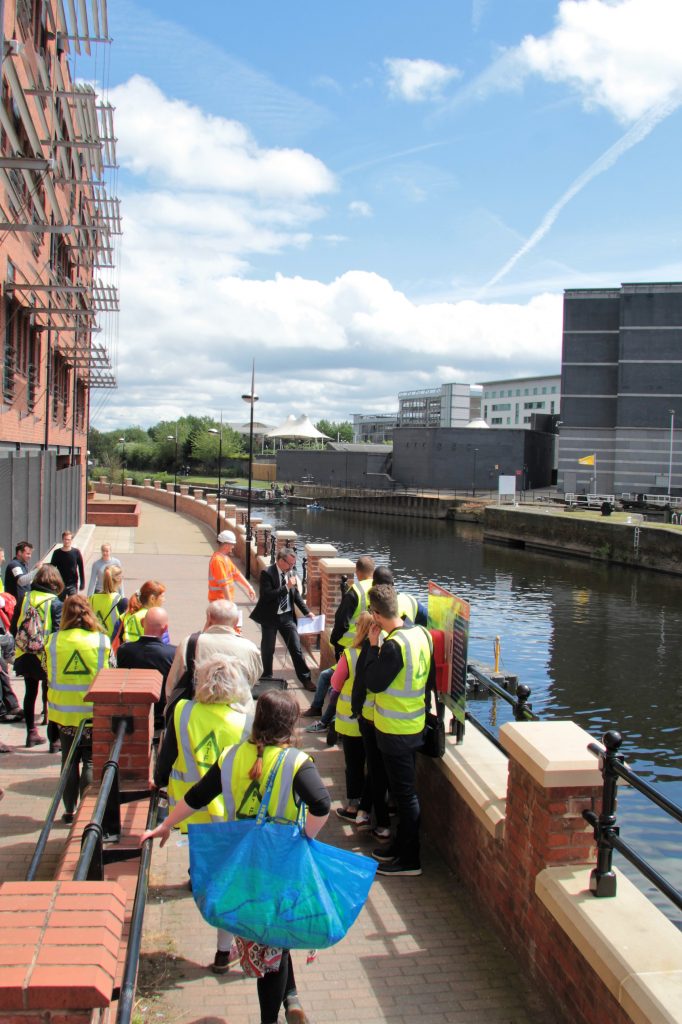 (We finish crossing the river… at the ramp on the way down, GUY points out that this too is an improved flood risk asset… and improvises lovingly about how spectators want to touch the new Ferrocast railings… “not too hot, not too cold”)
(We finish crossing the river… at the ramp on the way down, GUY points out that this too is an improved flood risk asset… and improvises lovingly about how spectators want to touch the new Ferrocast railings… “not too hot, not too cold”)
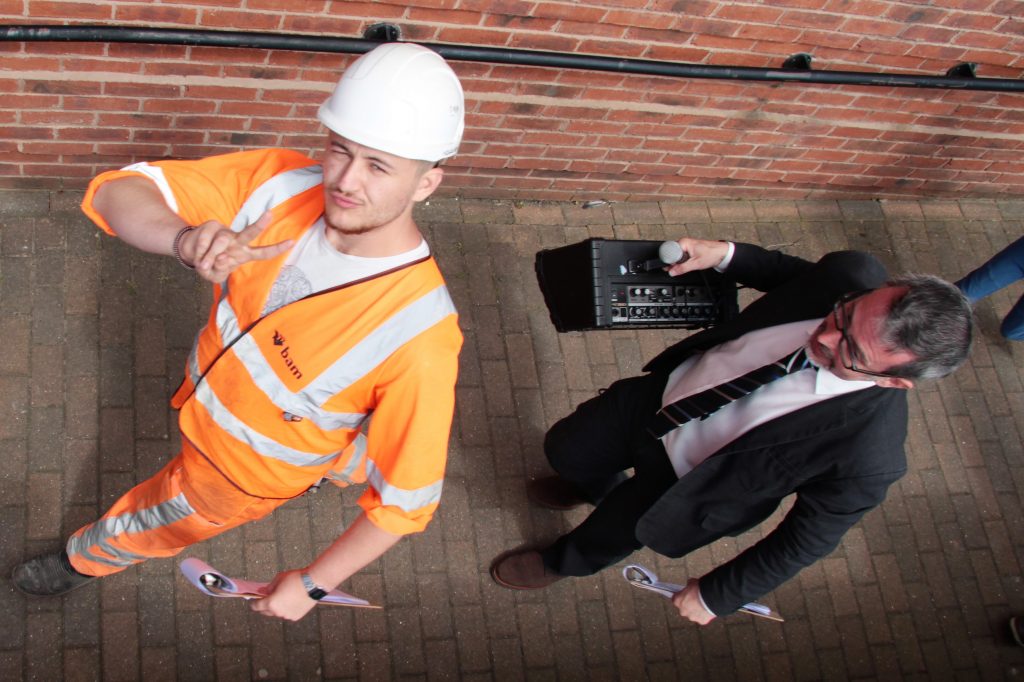 FOUR: In front of Turlow Court flats
FOUR: In front of Turlow Court flats
GUY: (with his back to the river) Now then, ladies and gentlemen… Notice how this new flood wall doesn’t look nearly as high from this side as it did from the river side…
JACK: That’s because we’ve built the pathway up to a higher level with all this tarmac, so people can see over the wall…
GUY: Remember, we at the council fought for lower wall heights in this scheme… we didn’t want walled-in alleyways …
JACK: To be honest, we didn’t build this path up quite this high to begin with… but we piled on more tarmac because the residents in these flats complained…
GUY: Ah yes, the residents! (now moving across so that he is standing in front of the building entrance) Turlow Court! Now… I know you’re not going to believe this – it really is quite a coincidence – but I do in fact live here in these . . . apartments. So I know this story from both sides! At the Council we’re commissioning Jack’s company to do the work… but then Jack’s company have to get in touch with me as a resident to see if I’m OK with what’s happening… (he is amused by this irony)
JACK: Well, we do our best to liaise with residents about noise levels and so on. The pile driving can get pretty loud and repetitive…
GUY: Bang! Bang! Bang!
JACK: … so you have to negotiate what times of day it’s least disruptive to be doing it…
GUY: And we weren’t best pleased when we had the fumes from your diesel generator pumping in the window…
JACK: (ignoring him) Generally, I’m glad to say, the residents here have been very understanding…
GUY: (conceding the point…) And generally, the foremen have been pretty responsive to our complaints… although we’ll certainly be glad when they’ve gone. (hastily, to JACK) Nothing personal! … Of course, the residents here know better than anyone how much this flood alleviation scheme is needed! This spot right here is one of the lowest on the entire Leeds waterfront… When the floods hit on Boxing Day, the entire ground floor was a meter and a half under water… our downstairs neighbours had to move out for months during the refurb…
Fortunately, we live higher up, so we didn’t have water in the apartment. But we were basically trapped for 3 days, because this place was like an island! Completely surrounded by water, well out to the main road… Luckily we had plenty of food in because it was Christmas, so, you know, Blitz spirit and all that!
What you might not know, though, is that there’d been two earlier floods that same winter, right in this very spot… November 14th – which was the date of the Paris terrorist attacks, so we didn’t rate a mention in the news – but the footpath here was underwater, and there were these big floating platforms that got swept down into the old weir – just caught against it…
JACK: Those were the platforms they were using up at the railway station – by the Dark Arches — when they were building the new South Entrance…
GUY: And then again, on December 12th – there was water up to the top of these steps and we had the sandbags out across this door. Someone actually drowned that time… they lost their footing with the footpath underwater… just got swept into the river… So this is serious stuff. And it really underlines just how important this flood alleviation scheme is…
(Pause)
JACK: OK we’ve got one last location to show you… I need you to come around this way please…
(We continue around the building, across the car park, and into a normally padlocked construction area…)
FIVE: Directly overlooking the weir
As the crowd reassembles, GUY displays some photographs taken by “my neighbour, Jim Willson” of Turlow Court, showing this car park after the Boxing Day flood, under inches of mud…
And the same car park with a mobile crane in it, during the construction of the first weir gate…
GUY: This has been the main inconvenience for Turlow Court residents, really – having to sacrifice part of our car park for the duration of the works…
But let me direct your attention now to the operating booth for the new weir gates, just over here… The building’s not quite finished but the systems are all installed inside already… There’s a big dial that says “Bladder Control”. I could probably do with fitting one of those! (ha ha ha) No but seriously folks, this is a big undertaking for us – thinking about the continued maintenance and operation of these weirs… Normally a big scheme like this would be run by the Environment Agency, because they have lots of operating experience with these things… But because it was the city council that really pushed for the installation of this system, it’s also the council that’s taking key responsibility for running it… and we’re really on a massive learning curve – trying to run all the scenarios for what we’d do in situation x, y or z … how we’d calibrate the weir heights… because every flood event is different, as we’re discovering!
But there is a real will to make this work. There is a real will and commitment for us to be doing what we can for our city!
JACK: (moving things on from the sales pitch) But you’ll be wanting to get a clearer look at the new weir… (he invites people to look out…) … before we reopened this bit below us, there were little wet otter footprints down here… all over this heritage weir section…
… oh and speaking of wildlife… see over there…? That bit of stray sheet piling sticking up out of the water? That was all supposed to have come out by now – it’s part of the first coffer dam we built, to construct this section of the weir – but we couldn’t take it out because a moorhen has made her nest right there, against the upstream side of the metal…
Now, legally and morally, we had to protect the nest. We have a “zero risk” policy on all our construction sites – and that includes taking zero risk with the health and safety of wildlife… So we had to work around the moorhen, but we couldn’t leave all those piles in either, so we had to find a way to cut those surrounding piles down to the levels you see now… and do it so that the vibration from the steel saw didn’t damage the nest…
Working around that nest cost about a week and a half’s progress on site…that means overhead costs of something over £70,000… So that’s one expensive nest!
She laid 5 eggs in her first batch – the chicks were all paddling about – little balls of fluff – but they all died… got swept away or taken by predators… Still, moorhens can lay clutch after clutch, so she went right back to the nest and laid 6 more…
(During certain performances, the moorhen chicks were visible at this point, paddling around!)
GUY: Ladies and gentlemen, we’re just about done here, but before we go, it would be remiss not to tell you exactly what level of protection this new system provides us with. When we first did the modelling for this scheme, it was calculated that the new weirs and walls would defend the centre of Leeds against a 1 in 75 year flood event…
Now, what does that mean, I hear you ask? Since we had a big flood here two years ago, does that mean there won’t be another one for 73 years? Unfortunately not! Jack, can I have that demonstration model, please?
(JACK produces plastic tubs and orange ping pong balls.)
Let’s explain this using a metaphor we can all understand – the National Lottery! Only in this case, it’s the British Weather Lottery, which I think we’re all pretty familiar with… Here we have 75 ping pong balls, in hazard orange (JACK pours them into big tub) Now – one of these balls represents a major flood event. A 1 in 75 year flood event! (he pulls it out, marked with black) Which means that, in any given year, there is a 1 in 75 chance that we’ll be hit by that level of flooding… like a ball coming up in the weather lottery! But here’s the thing — if that ball comes up one year (throwing it back into the tub, shaking the balls up) there’s still a 1 in 75 chance that it’ll come up again the next year… and the next year after that… Now, admittedly, it’s getting pretty unlikely – in statistical terms – that something like that would happen repeatedly – but still, it could happen. That’s probability calculations for you!
Now, as it happens, we;ve done some more work on the modelling since the scheme was designed, using new data — some of it from the Boxing Day flood — and we now reckon that it actually offers us better than 1 in 100 year flood protection!
(JACK adds another 25 ping pong balls to the 75)
Thankyou Jack. So now, we’re defending against even longer odds … a 1 in 100 year event is bigger and scarier than a 1 in 75, but we think we’re protected… And plus, there’s an additional allowance for climate change…
(JACK pours in yet more balls)
Now, we don’t actually have a number for that. And you might say, at this point, well now you’re just guestimating! And you know what, you’d kind of be right. Because even with the best minds and models in the world, weir science is not an exact science…
THere’s also one more caveat we need to bear in mind. Remember the Boxing Day flood? Well, we reckon that was a 1 in 250 year flood event…
(JACK adds another 150 balls… the box is getting full!)
So that’s an even bigger, scarier event still! And the odds of it happening are even longer… But the fact is that it did happen. And next year, it has a 1 in 250 chance of happening all over again… You might think, well, never mind, that’s a pretty slim chance. But who here buys National Lottery tickets? Do you know what the chance of winning the Lotto jackpot is? It’s roughly one in fourteen million. Now, Jack and I don’t have that many balls between us, but still — as the slogan has it — “It Could Be You!”
(a pointed pause)
Ladies and gentlemen, thankyou so much for joining us on our little tour. I’d like to thank my glamorous assistant, Jack…. (applause) … And I’d like to introduce you to my good friend Eddie Lawler, who is going to play us out with a song he’s written specially for this occasion… Eddie Lawler!
(Eddie performs his song “New Leeds Weir”)
End


